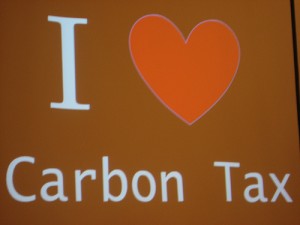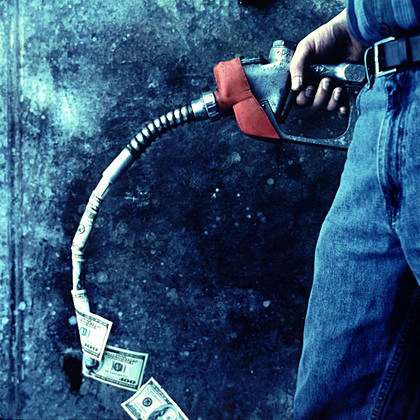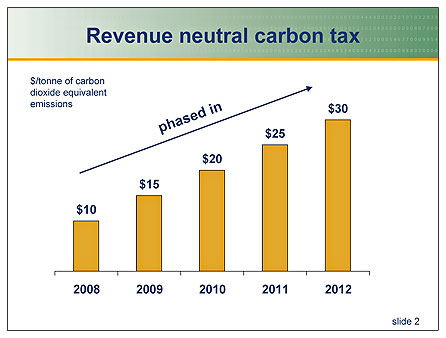CTC rep James Handley’s comment on columnist Eric Pooley’s recent piece “Exxon Works Up New Recipe for Frying the Planet” (Bloomberg) sparked this illuminating, constructive exchange.
Dear Mr. Pooley,
Thanks for your article. Climate crisis deniers are indeed doing great harm. Are they really changing tactics from bogus science to bogus economics or just using both? I was with you until I read this:
“A tax wouldn’t guarantee any carbon reductions, let alone bring about the steep cuts needed to stave off the worst climate changes.”
If you’re suggesting that a cap would “guarantee” emissions reductions in some way that a tax would not, I must disagree.
Consider economist Alan Viard’s Aug. 4 testimony to the Senate Finance Committee:
If the market price of allowances under cap and trade is $20 per ton, every firm has an incentive to take any step that can reduce emissions at a cost of less than $20 per ton, but no incentive to take any step that reduces emissions at greater cost… precisely the incentive that each firm would face if it were subject to a carbon tax of $20 per ton or if it were subject to a cap-and-trade program (with the same $20 allowance price) in which all allowances were auctioned.
… The difference, of course, is that the carbon tax or the auction would raise government revenue equal to the aggregate value of the allowances. If the allowances are freely allocated, then that value instead accrues to firms. Cap and trade with free allocation is equivalent to a carbon tax with transfer payments to firms.” [Emphasis added.]
I work with the Carbon Tax Center because, along with most  economists who’ve considered the question, I’m convinced that a clear, transparent, gradually-increasing price on carbon pollution is essential to spur energy conservation as well as development and implementation of alternatives to fossil fuels. A carbon tax, with revenue recycled directly to households to build political support and mitigate the economic impacts of what portends to be a decades-long trek to a low carbon economy, offers a real “game changer” to move broadly enough to substantially mitigate climate catastrophe.
economists who’ve considered the question, I’m convinced that a clear, transparent, gradually-increasing price on carbon pollution is essential to spur energy conservation as well as development and implementation of alternatives to fossil fuels. A carbon tax, with revenue recycled directly to households to build political support and mitigate the economic impacts of what portends to be a decades-long trek to a low carbon economy, offers a real “game changer” to move broadly enough to substantially mitigate climate catastrophe.
British Columbia has shown that a revenue-neutral carbon tax can be implemented in a few months and gain public support. And it’s far more effective than trading in carbon allowances, especially with offsets. Price volatility has prevented the EU’s cap-and-trade from spurring investment in alternative energy and conservation. See e.g., EU Cap-and-Trade System Provides Cautionary Tale (Roll Call).
The enemy of my enemy isn’t necessarily my friend. Climate crisis deniers’ opposition to cap-and-trade doesn’t make it a good idea. And the “endorsement” of a carbon tax by (former?) deniers can obscure the fact that a growing environmental and social justice coalition is advocating a carbon tax with revenue-recycled to households. Please don’t help the “deniers” poison the water for the most effective, transparent climate policy.
– James Handley, Carbon Tax Center
———-
James,
Thank you for your very thoughtful note. A full treatment of the cap v. tax debate was beyond the scope of the column, but I didn’t mean to suggest that a well -designed tax would be unworkable, rather that any tax Exxon would support is likely to be ineffective.
My basic concern here is political rather than economic– that the carbon tax will siphon enough support to derail cap and trade, but not enough to pass, and we will be left with nothing. I tend to agree with Al Gore when he points out that the nations that have been most effective in reducing emissions have both a cap-and-trade program and a carbon tax in place; ultimately we are likely to need both as well, but that’s a ways off. In the meantime, as Gore has said, “a cap-and-trade system is also essential and actually offers a better prospect for a global agreement, in part because it is difficult to imagine a harmonized global CO2 tax.” The fact is, cap and trade is the only climate program that has a chance of passing now. There’s a big game going on inside the stadium, but the carbon tax proponents are outside in the parking lot, dreaming about next year.
I don’t think cap and trade is (as many tax proponents have argued) a faintly disreputable cousin to the tax which no one would welcome if the tax itself were passable now. I think the cap has real advantages, which I’ll get to. I understand the longing for a simpler approach to the problem but have my suspicions about the simplicity argument; a tax bill would have to respond to the same legitimate regional and sector cost issues that complicated Waxman-Markey, so a bill that could pass would not be simple. How for instance would the straight per capita tax rebate or payroll offset I often see proposed deal with the higher cost burden in coal-dependent states? Staffers on the Hill tell me that adjusting the tax every few years would require a new Act of Congress every few years — it’s hard enough to get this done once.
The free allowance formula devised by EEI and incorporated in Waxman-Markey, by taking into account carbon intensity, isn’t perfect but does a good job of responding to the regional disparity issue. And since the bill requires LDCs [local (electric) distribution companies] to pass on the value of all allowances to their ratepayers, it would prevent the LDCs from enjoying windfalls. Alan Viard’s testimony ignores this requirement when it claims that the value of free allowances accrues to firms. That’s not how the bill works—it’s one of many misconceptions about Waxman-Markey. Overall I’m impressed with the way Waxman et al. learned from the mistakes in the EU ETS. Over-allocation and lack of baseline data were the biggest drivers of volatility there, and this program would avoid those. Nor would utilities be able to charge opportunity costs to their ratepayers, as EU generators did. Giving the transitional allowances to LDCs instead of generators solves other problems as well. It sends a clean price signal to the generators while cushioning ratepayers.
As for the ‘guarantee,’ of course there is no magic wand. But the cap is more than a price signal. We do have the technology to monitor and verify reductions, and I want to see that framework put in place as soon as possible. Finally, no one seems to talk about the penalties for busting the cap, which under Waxman-Markey amount to 2x the allowance price plus a replacement allowance, or three times to compliance incentive — under your $20/ton comparison, the compliance incentive for the cap is actually $60 per allowance, vs. $20 for the tax, plus the strong market signal driven by the knowledge that the cap is ratcheting down over time. The aggressive 2030 reduction target in Waxman-Markey — 42% below 2005 levels —has not received the attention it deserves. It would transform the energy investment decisions of American businesses.
Thanks again for your email and for your work at the Carbon Tax Center. I really would welcome either a tax or a cap. But at the risk of turning your words against you, let me suggest, as someone who has been watching this debate unfold, that it is the carbon tax advocates who have at times been poisoning the water against the cap. Probably both sides have been guilty of this, but it’s too bad that the climate action community is divided at the very moment unity is so badly needed.
– Eric Pooley
———-
Eric,
Thanks for your reply. I think we’re in strong agreement on most points. I want to respond to three:
1) You wrote: “My basic concern here is political rather than economic– that the carbon tax will siphon enough support to derail cap and trade, but not enough to pass, and we will be left with nothing…”
Fortunately, it’s not ACESA or nothing. Although, given that ACESA’s attempted domestic emissions reductions are so modest, and that its cap-and-trade system would entrench Wall Street traders and purveyors of offsets and set the stage for another financial crisis, I’d probably opt for nothing.
If ACESA fails to pass, EPA can continue to develop a regulatory system under the Clean Air Act, which the Center for Biological Diversity has concluded could be quite comprehensive (and might include a cap-and-trade system). This is likely to be better than ACESA in several key ways. For instance, I gleaned from EPA’s Advance Notice of Proposed Rulemaking last year that its rule would not include offsets. (Can you imagine EPA trying to justify the up to 1.5 billion tons of international offsets — essentially, transfer payments — that make a mockery of the notion of a “hard cap” in ACESA?) Furthermore, ACESA as passed by the full House would eviscerate EPA’s proposal to account for indirect impacts of biofuels (e.g., forest clearing to grow corn for ethanol).
Because the Clean Air Act covers stationary sources, mobile sources and the content of fuels, the scope of an EPA GHG reduction program can be very broad. President Obama’s representatives could go to Copenhagen with an EPA draft rule in hand, pointing out that the U.S. is in the process of regulating (or “capping”) more of its GHG sources than any other industrialized nation. That’s far from the most effective policy (a revenue-neutral carbon tax) but it’s also a long way from “nothing.”
2) You quote Al Gore “…a cap-and-trade system is also essential and actually offers a better prospect for a global agreement, in part because it is difficult to imagine a harmonized global CO2 tax.”
Gore’s got it backwards. As the Congressional Budget’s report, “Policy Options for Reduction of CO2 Emissions,” explains, if nations choose different carbon tax rates (or fail to enact them) WTO authorizes border adjustments to equalize tax rates on imported products to the same levels applied to similar domestically-produced products. In effect, the U.S. would collect the carbon tax on imports from any country that didn’t enact its own, providing a powerful incentive for our trading partners to follow our lead.
In contrast, under cap-and-trade, harmonization would require determining the implicit carbon price in a system where carbon prices are hidden and fluctuating. The CBO observed, “Linking cap-and-trade programs would… entail additional challenges beyond those associated with harmonizing a tax on CO2.” The report noted, for example, that linked cap-and-trade programs tend to create perverse incentives for countries to choose less stringent caps so they could become net suppliers of low-cost allowances.
Moreover, as Elaine Kamarck of Harvard’s Kennedy School has pointed out, almost every nation has a tax collection mechanism that could be used to administer a carbon tax, but few (if any) have the means to enact and enforce a complex cap-and-trade system. If we’re going for a global carbon reduction system, it’s a carbon tax.
3) You wrote: “…a tax bill would have to respond to the same legitimate regional and sector cost issues that complicated Waxman-Markey, so a bill that could pass would not be simple… adjusting the tax every few years would require a new Act of Congress every few years — it’s hard enough to get this done once.”
The complexity (and length) of Waxman-Markey seems to have much more to do with preserving (and even expanding) the coal industry than with addressing regional disparities in household income caused by carbon pricing, which, in fact, are relatively small. (See our summary: Regional Disparities.)
Economist Dallas Burtraw (Resources for the Future) studied the regional “incidence” of carbon pricing and concluded that regional differences are dwarfed by very large disparities across the income spectrum. CTC’s proposed carbon tax shift would more than compensate for the inherent regressivity of a carbon tax by distributing revenue progressively either through a payroll tax cut (as proposed in legislation introduced by Rep. John Larson) or a direct, equal distribution. Waxman-Markey only attempts to compensate the lowest income group, leaving middle income households to shoulder the burden of carbon pricing. (Burtraw and others have also shown that ACESA’s free allowances to LDCs would mostly benefit commercial, not residential electricity users.)
We recognize that some regional adjustment might also be needed; but that’s a relatively simple proposition under a carbon tax and could be done administratively, without the need for legislation. Rep. Larson’s bill provides for automatic increases in the carbon tax level to ensure that the trajectory of emissions reductions is in line with the scientific consensus.
Thanks again,
James
———-
James,
I think you’re kidding yourself about the EPA’s ability to impose cap-and-trade under CAA. Someone who knows a lot more about politics than either of us, former White House Chief of Staff John Podesta, has said it would be difficult for EPA to do so without Congressional assistance. Protracted litigation would see to it that years went by before such a system came into force. And there is no chance that an administration promise of such rulemaking – which any subsequent administration could undo – could form the basis of a treaty.
Dallas Burtraw is a fine economist, but the many Senators and members of Congress I have been talking to all summer simply do not agree with him. Regional and sectoral disparities are the single biggest obstacle to climate action, and lawmakers do not believe that the “simple carbon tax” solves them. That’s why Rep. Mike Doyle of Pennsylvania backed Waxman-Markey instead of John Larson’s carbon tax. It’s one of the reasons Waxman-Markey passed the House and Larson’s bill didn’t make it to markup. If the politics were reversed and a carbon tax had a shot at passing, I would expect cap-and-traders to get behind the carbon tax and push hard. But right now, it is the cap that has a real chance of passage, and it could be years before the next opportunity presents itself. Please don’t let your strong shoulders go to waste.
– Eric
———-
Eric,
Regional and income disparities arise under either a carbon tax or cap-and-trade (in fact, Burtraw considered it the same problem), but it’s easier to mitigate these regional and income disparities under a transparent carbon tax by directly distributing the revenues to households.
Rep. Larson and the other members of the Ways and Means Committee, which held a series of very illuminating hearings last spring about the very serious volatility and gaming with cap-and-trade, didn’t get a shot at climate legislation because the House leadership didn’t permit amendments – they didn’t want any discussion of alternatives to cap-and-trade.
I agree with economist Robert Shapiro (Clinton undersecretary of Commerce and U.S. Climate Task Force co-chair) who said at our July 13 Senate briefing that ACESA deserves to be defeated. He fears that, as in the E.U., cap-and-trade would fail to reduce emissions and would delay needed reductions by a decade or more. I cannot support a hidden, volatile and regressive carbon tax (set and collected by Wall Street) whose main advantages seem to be that it hides the price and is called “cap-and-trade”. I believe an explicit, predictable and progressive carbon tax with revenue recycled to households is essential. British Columbia’s experience shows that a revenue-neutral carbon tax is politically feasible. But, to return to my original point, first we need to get beyond magical thinking about “caps”.
– James
photo: Flickr / random dude

 For months we’ve been
For months we’ve been 